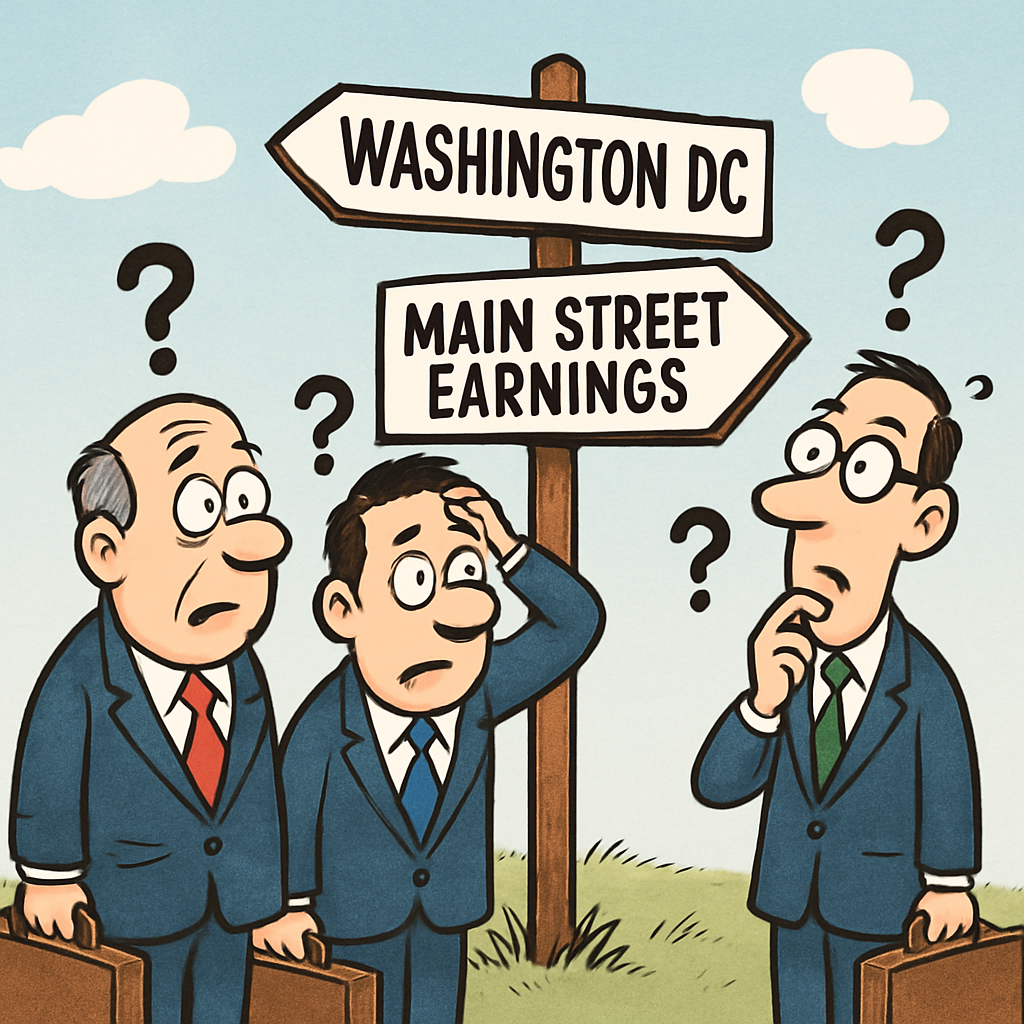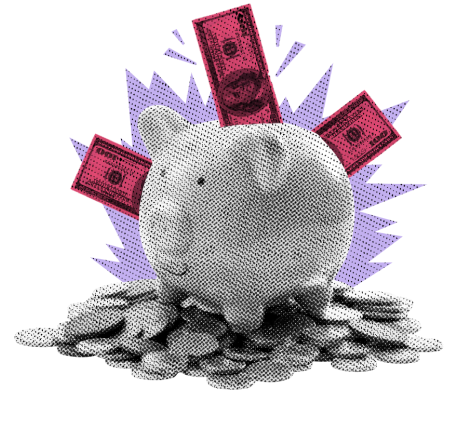
With Washington silent, corporate earnings take the mic–and so far, they’re singing a surprisingly healthy tune.
KEY TAKEAWAYS
-
The government shutdown has paused official data for 21 days, but markets are thriving
-
Bond yields are falling even as inflation ticks up, signaling expectations of slower growth
-
The Fed remains active and is widely expected to cut rates soon
-
Corporate earnings are strong, especially from Dow components like Coca-Cola and 3M
-
Fundamentals–not fear–are driving markets higher in the absence of official data
MY HOT TAKES
-
Markets don’t need constant government data to function
-
Corporate earnings are a better measure of real economic health
-
Gold’s rise is fear; the Dow’s rise is faith
-
The Fed’s influence is waning as fundamentals take the lead
-
Capitalism always adapts–even in a blackout
-
You can quote me: “When Washington goes dark, Wall Street still has spreadsheets.”
Apple pie. Here we are. Twenty-one days in. We have almost missed an entire month of government agency economic numbers, and guess what? We are still alive. In fact, we are thriving. How is it that a market that is obsessed with knowing everything be at, or around all-time highs? We know that the labor market is struggling–at least based on the four months leading up to September. We have no clue about what happened in September because we did not get the monthly jobs report from the Bureau of Labor Statistics (BLS) earlier this month because of the shutdown. It is fair, however, to assume that the labor market did not stage a massive, flash recovery in September.

We also know that investor tension is running high based on gold’s recent rocket ride–a pure fear play, overaccentuated by foreign central bank buying. Another sort of fear gauge is bond yields, specifically longer maturity Treasury Note yields. From spring through this morning, 10-year Treasury Note yields have fallen from around 4.6% to 3.95%. Throughout that period, inflation has ticked up, which usually causes yields to climb. How can this be? Well, to be sure, there are many drivers, but the safest conclusion is that though we are seeing some inflation today, it is likely to decrease in the future due to weaker consumption and demand. In other words, a softening of economic growth. Remember, 10-year yields reflect inflation assumptions over a bond’s life, and 10-years is well… a long ‘ways away, but even so, longer-maturity bond yields falling represents an expectation that things may be rocky ahead.

Looking at the economic calendar over the past 21 days–it is sparse–we note the following. Thanks to private economic research, we know that the services sector (ISM Services Index) weakened slightly in September but is still expanding (but is on the cusp of contracting), manufacturing (ISM Manufacturing Index) ticked up slightly last month (but is still contracting), the labor market may be gasping (ADP Employment Change), consumer sentiment (preliminary October University of Michigan Sentiment) may be holding up (propped up by increased optimism of the current–not future–conditions), small business may be slightly less optimistic (NFIB Small Business Optimism Index), and housing market conditions improved (NAHB Housing Market Index).
It turns out that not everyone is on a forced vacation in Washington DC. The Federal Reserve is still quite active. From the Fed’s usually-quite-beige, Beige Book, we learned that the economy may be stuck in neutral with stable jobs, steady spending, and stubborn inflation. Also, businesses aren’t collapsing, but they’re not expanding either, and tariff costs are quietly eating into margins. The September FOMC minutes showed a cautious Fed with most members expecting more cuts this year. But disagreement is–or was, rather, brewing over how fast to move with inflation still sticky. In the New York Region, business activity (Empire Manufacturing Survey, a regional Fed report) grew modestly with an increase in optimism over new orders.
Oh, and there are the FOMC members themselves–the very folks who are charged with pushing and pulling the levers of the US economy. You can say they are important. 🤣 You can also say that they love to talk, and they have been doing so, helping to fill the vacuum caused by the shutdown. My good friends over at Bloomberg Economics carefully monitor all the chatter to come up with a spectrometer. According to their assessment, out of 12 FOMC voters, we have 3 uber doves, 2 doves, 5 neutrals, 1 hawk, and 1 uber hawk. I think it is safe to say that the hawks are sitting at a very lonely lunch table at Fed HQ these days. According to Fed Funds futures, there is a 96% chance of a 25 basis-point rate cut at next week’s meeting and a 98% chance of a rate cut in December’s meeting. On Wall Street, those are considered good odds. 😉
That brings us to earnings season, which should ALWAYS be the ultimate arbiter of economic health. I spend a lot of time talking about the strength of the consumer, but without jobs PROVIDED BY COMPANIES, consumers are powerless. In addition to their impact on consumers, corporate investment is a big part of US economic growth. Get my point? Corporate health is important. So, with a lack of “official” government economic data, and limited private data (☝️😉), we must turn to the real drivers of economic health. Those drivers just happen to be undergoing their quarterly checkups as we speak.
It’s far too early in earnings season to form any conclusions yet, but the results to date have been interesting. I am going to simplify things and focus on the Dow Jones Industrial Index, which closed at an all-time high yesterday. As a refresher, the Dow Jones Industrial Average is a price-weighted index of 30 large US companies that are supposed to serve as a snapshot of blue-chip corporate America. With the Dow, it’s less about precision and more about perception. It is a century-old barometer of market mood that still moves headlines even if guys like me look elsewhere for real depth. Stay with me. Now, even though the Dow has the word “Industrial” in its names, its members span far beyond the industrials sector. You can say that it is a very diverse group where chemical makers, oil drillers, white-shoe bankers, and high-tech/AI rockstars rub elbows. Its forward PE ratio is above 20, meaning that it is expensive at the moment, but its EPS growth is expected to have declined from Q3 of last year. A mixed signal from the mixed group.
We have so far heard from 8 of the members and they all handily beat EPS estimates (by 6%). All but one (Nike) demonstrated year-over-year earnings growth (aggregate growth: 15%). The Nike decline in earnings from last year is all about weak demand in China and margin compression from tariffs–a telling story of this current economic regime. Financials came in strong (19% aggregate EPS growth) with all but 1 reporting (Visa) to date. It was yesterday’s announcements from members Coca-Cola and 3M that pushed the old index to its all-time high, and that is important to note, because neither are sexy, shiny growth stocks. That, to me, is an important signal that corporations and consumers are healthy.

And let’s be honest, nothing says “America is doing fine” like a fizzy drink and some Scotch tape. 😄 When companies like Coca-Cola and 3M can move markets, it’s a reminder that fundamentals still count, even in a world obsessed with AI chips and crypto. These are the businesses that sit in pantries, garages, and factory floors across the country. You don’t buy Coca-Cola stock because you expect a moonshot; you buy it because it’s a staple (and its dividend isn’t too bad either 😉). You buy it because its brand and margins endure recessions, pandemics, and policy uncertainty. And that endurance is what the market is rewarding right now.
In the absence of government data, corporate earnings are our best health check on Main Street. They tell us who’s hiring, who’s cutting, who’s discounting, and who may be able to pass along price increases. If Walmart says prices are up because of tariffs (they announce next month), that’s inflation data. If FedEx says shipping volume is slowing (we will hear from them in December), that’s growth data. And when banks like JPMorgan and Goldman report strong net interest income but cautious consumer lending, that’s policy data. In other words, the story of the US economy isn’t frozen, it is just being told by a different set of narrators.
To be sure, this setup creates a strange kind of transparency paradox. The shutdown has unplugged the usual government megaphone, and yet the private and corporate data flooding in is giving us more nuance than usual. Instead of the traditional, iconic jobs report, we have micro stories in earnings transcripts, footnotes, and CEO guidance, and so far, they are all painting a mosaic of resilience. Some sectors are taking hits from tariffs or global slowdowns, but others are still expanding. The economy, as messy and uneven as it is, appears to be adapting rather than collapsing.
The bond market, meanwhile, seems to be reading the same story but turning the page faster. Yields are dropping not because of panic, but because investors see a slower, gentler economy ahead. The Fed’s next rate cut, widely telegraphed and nearly priced in, likely won’t spark fireworks, it will simply confirm what markets already believe: that policy will continue to align with the real economy. If anything, the Fed is now more of a supporting actor than the lead. It’s earnings, not the Beige Book, that are driving sentiment.
What’s most fascinating about this moment is the simple signal of the data itself. Usually, we’re inundated with numbers that give the illusion of precision. We get GDP revisions, CPI prints, PCE deflators, employment cost indexes, etc. Now, in this blackout, we are seeing how markets behave when forced to look past the precise decimal points. And what we are seeing so far is a simple truth: the American economy is fundamentally healthy. Not booming, not crashing, just moving forward, powered by companies that make things people actually need, and people who still have jobs to pay for them.
The Dow at record highs isn’t a statement of exuberance, it’s a quiet vote of confidence in the system itself. It’s an acknowledgment that the lights are still on, even if the data dashboard is dark. Think of it as flying through clouds: you can’t see the ground, but the instruments, like corporate earnings and consumer behavior, are all pointing in the right direction. If anything, this blackout has made us better listeners.
Of course, this doesn’t mean the ride ahead will be smooth. We are still facing inflationary friction, global trade stress, and political crosswinds. The tariff story isn’t going away anytime soon, and the Fed will have to balance its cuts against the risk of reigniting price pressures. But for now, markets are showing faith in the fundamentals–earnings, balance sheets, and brand endurance. The American corporate machine may not be sprinting, but it’s certainly not stalling.
So here we are, three weeks without the government scoreboard, and the market has managed to keep playing the game just fine. Maybe this is a reminder that capitalism, which is at times messy, ever adaptive, always self-correcting, doesn’t always need a referee. The players know how to adjust. They always have. The Fed will cut rates soon, the data will start flowing again, and analysts will resume arguing about basis points and labor-force participation rates. But we’ll remember this stretch as a moment when the absence of information forced us to focus on what actually matters.
The economy, like the Dow itself, is a story of endurance and optimism. We may not have the numbers at the moment, but we still have the narrative, and it remains a good one. Companies are making money, people are spending, and even the old industrials are pulling their weight. For now, that’s enough. Apple pie, Coke fizzing, markets humming, and the data may be dark, but the fundamentals are shining just fine. Hopefully that pie and can of Coke gave you energy, because your mission is to remain focused–we still have a long row to hoe.
YESTERDAYS MARKETS
Stocks had a mixed close yesterday and the Dow hit all-time highs yesterday on strong earnings from Coca-Cola and 3M. The pace is just about to pick up with earnings and investors are pensive with high expectations. Treasury note yields fell below 4% and gold got hammered, declining by -5.3%.

NEXT UP
-
Not official government data because… er, you know why 😉, but we will get important earnings announcements from Lennox, Hilton Worldwide, Thermo Fisher Scientific, Boston Scientific, AT&T, Southwest Airlines, Alcoa, O’Reilly Automotive, Tesla, Annaly, United Rentals, Lam Research, Knight-Swift Transportation, Kinder Morgan, Las Vegas Sands, Viking Therapeutics, and IBM.
.png)

